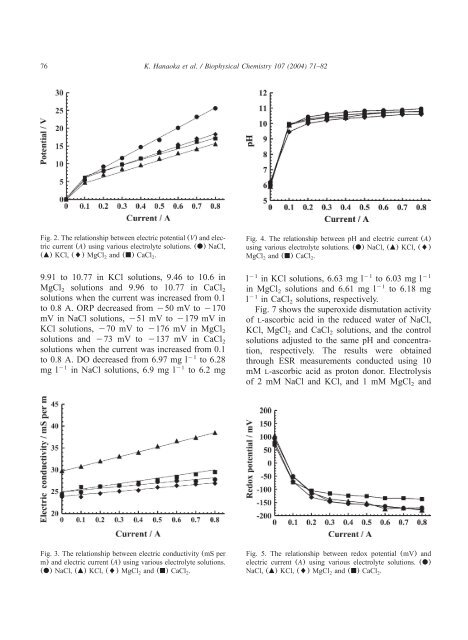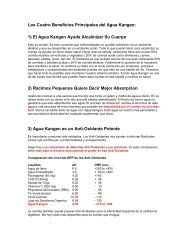ACID-ALKALINE BALANCE: ROLE IN CHRONIC ... - My Kangen Tools
ACID-ALKALINE BALANCE: ROLE IN CHRONIC ... - My Kangen Tools
ACID-ALKALINE BALANCE: ROLE IN CHRONIC ... - My Kangen Tools
You also want an ePaper? Increase the reach of your titles
YUMPU automatically turns print PDFs into web optimized ePapers that Google loves.
76 K. Hanaoka et al. / Biophysical Chemistry 107 (2004) 71–82<br />
Fig. 2. The relationship between electric potential(V) and electric<br />
current(A) using various electrolyte solutions.(d) NaCl,<br />
(m) KCl,() MgCl and(j) CaCl .<br />
2 2<br />
9.91 to 10.77 in KCl solutions, 9.46 to 10.6 in<br />
MgCl2 solutions and 9.96 to 10.77 in CaCl2<br />
solutions when the current was increased from 0.1<br />
to 0.8 A. ORP decreased from y50 mV to y170<br />
mV in NaCl solutions, y51 mV to y179 mV in<br />
KCl solutions, y70 mV to y176 mV in MgCl 2<br />
solutions and y73 mV to y137 mV in CaCl 2<br />
solutions when the current was increased from 0.1<br />
y1<br />
to 0.8 A. DO decreased from 6.97 mg l to 6.28<br />
y1<br />
y1<br />
mg l in NaCl solutions, 6.9 mg l to 6.2 mg<br />
Fig. 4. The relationship between pH and electric current (A)<br />
using various electrolyte solutions.(d) NaCl,(m) KCl,()<br />
MgCl and(j) CaCl .<br />
2 2<br />
y1 y1 y1<br />
l in KCl solutions, 6.63 mg l to 6.03 mg l<br />
y1<br />
in MgCl solutions and 6.61 mg l to 6.18 mg<br />
2<br />
y1<br />
l in CaCl2<br />
solutions, respectively.<br />
Fig. 7 shows the superoxide dismutation activity<br />
of L-ascorbic acid in the reduced water of NaCl,<br />
KCl, MgCl2 and CaCl2<br />
solutions, and the control<br />
solutions adjusted to the same pH and concentration,<br />
respectively. The results were obtained<br />
through ESR measurements conducted using 10<br />
mM L-ascorbic acid as proton donor. Electrolysis<br />
of 2 mM NaCl and KCl, and 1 mM MgCl<br />
2<br />
and<br />
Fig. 3. The relationship between electric conductivity(mS per<br />
m) and electric current(A) using various electrolyte solutions.<br />
(d) NaCl,(m) KCl,() MgCl and(j) CaCl .<br />
2 2<br />
Fig. 5. The relationship between redox potential (mV) and<br />
electric current (A) using various electrolyte solutions. (d)<br />
NaCl,(m) KCl,() MgCl and(j) CaCl .<br />
2 2



